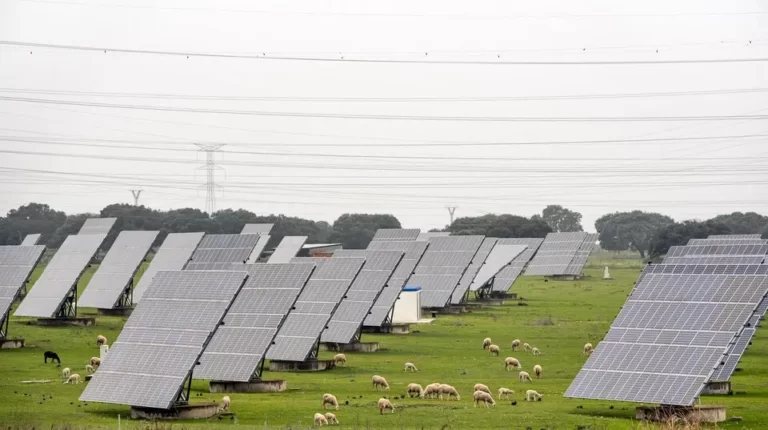Community solar power projects are an innovative way to provide affordable, renewable energy to households and businesses. These projects allow multiple customers to share the benefits of a solar project within a geographic area. As a result, more Americans can access equitable and sustainable energy, regardless of whether they have a suitable rooftop for solar energy systems.
Community solar is a type of distributed generation that can be installed on rooftops, parking lots, or open land. The electricity generated by these projects is fed into the grid and credited to the customer’s utility bills. This means that customers can receive the benefits of solar power without having to install and maintain their own solar panels. Additionally, community solar projects can be designed to provide energy to low-income households, schools, and other community facilities.
Community solar projects are gaining popularity across the country, and the Department of Energy is encouraging and empowering neighborhoods to build these projects. In this article, we will explore what community solar is, how it works, who can benefit from it, and answer some frequently asked questions. By the end of this article, you will have a better understanding of how community solar power projects can contribute to a sustainable lifestyle.
Key Takeaways
- Community solar power projects allow multiple customers to share the benefits of a solar project within a geographic area, providing equitable and sustainable energy to households and businesses.
- Community solar projects can be installed on rooftops, parking lots, or open land, and the electricity generated is fed into the grid and credited to the customer’s utility bills.
- Community solar projects can be designed to provide energy to low-income households, schools, and other community facilities, contributing to a sustainable lifestyle.
What is Community Solar?
Community solar is a solar energy system that is shared by multiple households or businesses. It allows people who are unable to install solar panels on their own property to benefit from solar power. With community solar, you can subscribe to a portion of a larger solar array and receive a credit on your utility bill for the electricity generated by your share of the system.
Community solar projects are typically located in a central location and can range in size from a few hundred kilowatts to several megawatts. They are connected to the grid, which means that the electricity they generate is fed into the local utility’s distribution system and is available to all customers in the area.
Benefits of Community Solar
There are many benefits to participating in a community solar project:
-
Solar access for everyone: Community solar allows people who are unable to install solar panels on their own property to benefit from solar power. This includes renters, people who live in multi-unit buildings, and homeowners whose roofs are shaded or not suitable for solar panels.
-
Lower electricity bills: By subscribing to a community solar project, you can receive a credit on your utility bill for the electricity generated by your share of the system. This can help lower your electricity bills and save you money.
-
Clean, renewable energy: Community solar projects generate clean, renewable energy that reduces greenhouse gas emissions and helps combat climate change.
-
Support for local communities: Community solar projects can be owned and operated by local organizations, which helps support the local economy and creates jobs.
-
No upfront costs: Unlike installing solar panels on your own property, there are no upfront costs associated with participating in a community solar project. You simply subscribe to a portion of the system and start receiving bill credits.
Overall, community solar is a great way to support sustainable energy and reduce your carbon footprint. It allows everyone to benefit from solar power, regardless of their living situation or financial means.
Community Solar Projects: How Do They Work?
Community solar projects are a way for individuals, businesses, nonprofits, and other groups to benefit from solar energy without having to install solar panels on their own properties. These projects are typically large, central solar power plants that generate electricity during the day and feed the local grid. The subscribers of the community solar garden get a share of the power produced through these solar arrays. Here’s a closer look at how these projects work.
Construction and Financing of Community Solar Projects
Community solar projects are typically developed by private entities, such as project developers, utilities, or investors. These entities finance and construct solar power plants, which are then connected to the local grid. The upfront investment required for these projects can be significant, but there are financing options available that can help reduce risks and make these projects more accessible.
One of the main benefits of community solar projects is that they allow individuals and small businesses to invest in renewable power and reduce their energy costs without having to make a large capital investment. This makes solar energy more accessible to a wider range of people and businesses, which can help promote sustainability and reduce greenhouse gas emissions.
Enabling Policies and Regulations
State governments and local utilities play a big role in enabling community solar projects. Policies and regulations that support the development of these projects can help create jobs, promote economic development, and reduce pollution. The Department of Energy’s Solar Energy Technologies Office and the National Renewable Energy Laboratory are two organizations that work to promote equitable and sustainable community solar projects.
In addition to enabling policies, project developers and utilities need to work closely with local communities to build relationships and engage with stakeholders. This can help ensure that the benefits of these projects are shared fairly and that the projects are designed to meet the needs of the local community.
Overall, community solar projects are an innovative and sustainable way to generate renewable energy and reduce our reliance on natural resources. By working together, individuals, businesses, and communities can help fight climate change and promote a more sustainable future.
Who Can Benefit from Community Solar?
Community solar is a great way for homeowners, renters, and businesses to benefit from solar energy without having to install panels on their own property. With community solar projects, you can subscribe to a shared solar array and receive credits on your electric bill for the power generated by your share of the system.
Community Solar for Homeowners and Renters
Community solar is an excellent option for homeowners and renters who want to benefit from solar energy without having to install panels on their own property. With community solar, you can subscribe to a shared solar array and receive credits on your electric bill for the power generated by your share of the system.
Community solar is especially beneficial for low-income households who may not be able to afford the upfront costs of installing solar panels on their own property. By subscribing to a community solar project, you can save money on your utility bill and help support the development of clean energy in your community.
Community Solar for Businesses
Businesses can also benefit from community solar projects. By subscribing to a shared solar array, businesses can save money on their electric bills and demonstrate their commitment to sustainable practices. In addition, community solar projects can help businesses meet their sustainability goals and improve their environmental and social impact.
Community solar projects can also benefit local communities by creating jobs, promoting economic development, and increasing awareness and education about the benefits of solar energy. Many states, including New Jersey, Florida, and New York, have established guidelines for community solar projects to ensure that they provide maximum benefits to the community while protecting the environment.
Frequently Asked Questions
-
What is a community solar project?
A community solar project is a solar energy system that provides electricity to multiple households or businesses in a community. This system is usually located in a central location, such as a rooftop or a nearby field. Participants can subscribe to the project and receive credits on their electricity bills for the energy produced by the solar panels.
-
How do community solar projects benefit the environment?
Community solar projects benefit the environment by reducing greenhouse gas emissions and promoting the use of renewable energy. By generating electricity from the sun, these projects help to reduce the reliance on fossil fuels and decrease the carbon footprint of the community.
-
What are some successful examples of community solar projects?
There are many successful examples of community solar projects across the United States. One example is the “Solar Gardens” program in Minnesota, which has over 200 megawatts of community solar projects installed or in development. Another example is the “NY-Sun” program in New York, which has helped to install over 300 megawatts of solar capacity across the state.
-
How can I get involved in a community solar project?
To get involved in a community solar project, you can first check if there are any projects available in your area. You can do this by contacting your local utility provider or searching online for community solar projects in your state. Once you find a project that interests you, you can sign up to become a subscriber and receive credits on your electricity bill.
-
What is the process for starting a community solar project?
The process for starting a community solar project can vary depending on the location and the regulations in your area. Generally, the process involves finding a suitable location for the solar panels, securing financing, and obtaining the necessary permits and approvals from local authorities. You may also need to work with a developer or a solar company to design and install the system.
-
What are the financial benefits of community solar projects?
Community solar projects can provide several financial benefits, including lower electricity bills, stable energy prices, and the potential for a return on investment. By subscribing to a community solar project, you can receive credits on your electricity bill for the energy produced by the solar panels. This can help to lower your overall energy costs and provide a stable source of energy for your home or business. Additionally, some community solar projects offer the opportunity to invest in the project and receive a return on your investment over time.

